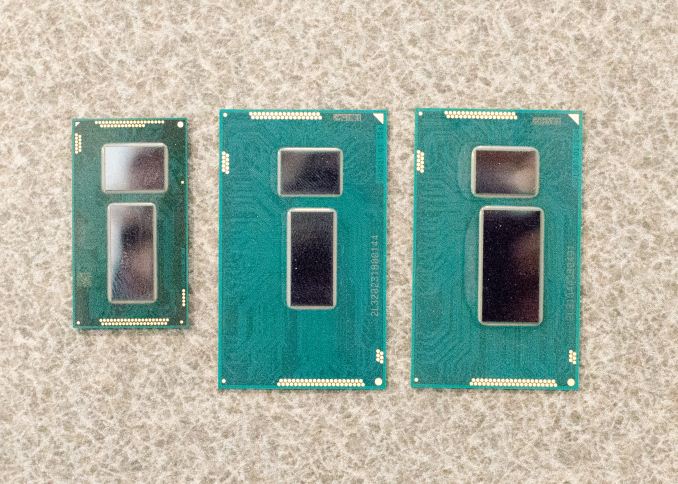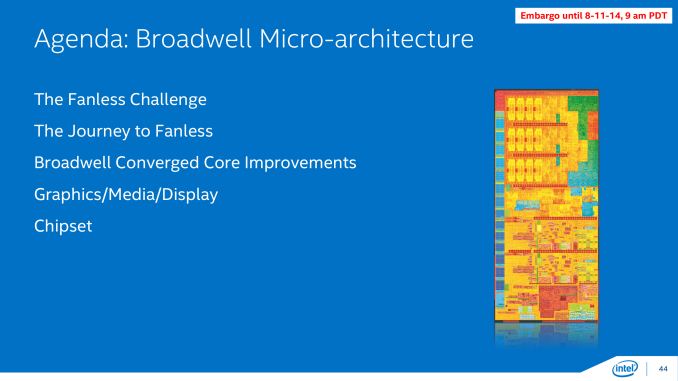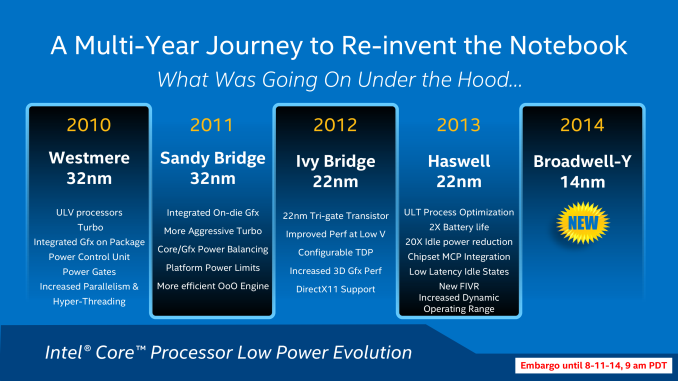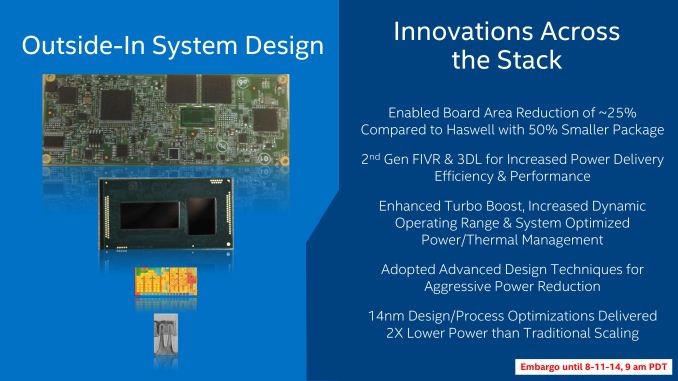Intel Broadwell Architecture Preview: A Glimpse into Core M
by Ryan Smith on August 11, 2014 12:01 PM EST
With Haswell Refresh fully behind us and 2014 now in to its second half, Intel is turning their attention to their next generation of products and processes. Intel’s tick-tock methodology coupled with the long development periods of new products means that the company has several projects in flight at any given time. So while we have seen the name Broadwell on Intel’s roadmaps for some time now, the reality of the situation is that we know relatively little about Intel’s next generation architecture and the 14nm process that it is the launch vehicle for.
Typically we would see Intel unveil the bulk of the technical details of their forthcoming products at their annual Intel Developer Forum, and with the next IDF scheduled for the week of September 9th we’ll see just that. However today Intel will be breaking from their established standards a bit by not waiting until IDF to deliver everything at once. In a presentation coinciding with today’s embargo, dubbed Advancing Moore’s Law in 2014, Intel will be offering a preview of sorts for Broadwell while detailing their 14nm process.
Today’s preview and Intel’s associated presentation are going to be based around the forthcoming Intel Core M microprocessor, using the Broadwell configuration otherwise known at Broadwell-Y. The reason for this is a culmination of several factors, and in all honesty it’s probably driven as much by investor relations as it is consumer/enthusiast relations, as Intel would like to convince consumer and investor alike that they are on the right path to take control of the mobile/tablet market through superior products, superior technology, and superior manufacturing. Hence today’s preview will be focused on the part and the market Intel feels is the most competitive and most at risk for the next cycle: the mobile market that Core M will be competing in.
To that end Intel’s preview is very much a preview; we will see bits and pieces of Broadwell’s CPU architecture, GPU architecture, and packaging, along with information about Intel’s 14nm process. However this isn’t a full architecture preview or a full process breakdown. Both of those will have to wait for Intel’s usual forum of IDF.
Diving into matters then, Core M will be launch vehicle for Broadwell and will be released for the holiday period this year. In fact Intel is already in volume production of the Broadwell-Y CPU and production units are shipping to Intel’s customers (the OEMs) to begin production and stockpiling of finished devices for the holiday launch.
Intel’s decision to initially focus Broadwell on the mobile market comes as the company takes the next step in their plan to extend into the Core processor series into these devices. Arguably, Intel has been slow to response to the rise of ARM devices, whose rapid rise has undercut traditional PC sales and quickly become the biggest threat to Intel’s processor dominance in some number of years. Intel is far from doomed right now, but even they see the potential farther down the line if they do not act.
Intel for their part has responded, but it has taken a step-by-step (multi-year) process that has seen the company progressively build smaller and less power hungry CPUs in order to fit the needs of the mobile market. Since Intel integrated their graphics on-die with Sandy Bridge in 2011, the company has continued to tweak the designs of their products, with Ivy Bridge and Haswell generation products introducing further optimizations and new manufacturing processes. Now on their latest iteration with Broadwell, the company believes they’re turning a corner and have the technology they need to be a leader in the high performance mobile market. It's important to note that despite Intel's best intentions here, Broadwell and Core M remain targeted at premium devices. You won't see these parts in cheap tablets. The duty of doing battle with ARM remains Atom's alone.
Many of these changes ultimately amount to boosting performance and reducing power consumption to a point where power and heat are where they need to be for mobile form factors, either through process efficiency improvements or through better power management and wider dynamic ranges – boosting where it matters and doing a better job of idling between tasks. However as Intel has discovered they not only need to be able to meet the TDP requirements of a tablet but they need to be able to meet the size requirements too. A particularly daunting task when the entire thickness of a device needs to be under 10mm, and the CPU thinner yet.
As a result, coupled with Core M’s performance improvements and power reductions is a strong emphasis on the size of the processor package itself and what Intel could do to reduce it. Intel calls this an outside-in system design, with various parts of Intel focusing on everything from the size of the logic board needed to hold the processor to the thickness of the processor die itself. In the following pages we’ll take a look at Intel’s efforts to get slim, but to kick things off we have a picture of Broadwell-Y from Computex 2014.

From left to right: Broadwell-Y (Core M), Broadwell ULT/ULX and Haswell ULT/ULX
Intel wants a greater foothold in the mobile market and they want it badly. And with Broadwell-Y they believe they finally have what they need to accomplish that goal.














158 Comments
View All Comments
isa - Monday, August 11, 2014 - link
I appreciate the thoughts, but I'm actually an ASIC designer, so I have no problem with lingo - I just am not informed regarding my specific question. And my current laptop is a Penryn 2008 laptop, so forgive me if we ignore the need question and stay focused on what version(s) of Broadwell are intended for mainstream (non-gaming) desktop replacement laptops. thanks!ZeDestructor - Monday, August 11, 2014 - link
You want the full HQ/MQ series for your next laptop. Those are the full quad-core-enabled machines, which is something your probably want for a hi-performance machine. Since this is a gaming laptop though, you may want to look into building a small mini-ITX desktop though, they're comparable if your primary definition of "mobile gaming" is "drag computer to a LANparty/friend's place" rather than actually gaming on a train or similar.name99 - Tuesday, August 12, 2014 - link
If you can afford it, why are you dicking around with trying to save a few hundred dollars?If you want a serious machine, buy an rMBP with quadcore i7.
If you want a light machine, buy an MBA.
Then either stick Parallels on it (if you use OSX) or just run Boot Camp and never touch OSX, except maybe once every two months to update the firmware.
If you can afford it, life's too short to waste time trying to figure out which of fifty slightly different laptop PCs will suck less in their different hardware, different pre-installed crap-ware, different drivers. Just pay a little more and get something that most people consider works well.
ZeDestructor - Tuesday, August 12, 2014 - link
As an ASIC designer, OSX is just a non-option. Hell, even Linux is rather hairy compared to Windows for ASIC stuff.I personally like the Dell Precision line, but Lenovo Thinkpad W and HP Elitebook would also doo. In a pinch, a ridiculously-specced Compal (in it's various Sager rebrands) would also do, but IMO are just not built anywhere close.
Kjella - Monday, August 11, 2014 - link
Y = tabletsU = ultraportables
H = laptop/desktops
EP/EX = workstations/servers
So H. Out in Q2 2015, by current best guesses.
isa - Monday, August 11, 2014 - link
Thanks, Kjella. Upon further googling after reading your post, I learned that there apparently will be a mobile and deskop version of the H flavor, and it does look like the mobile H is the most likely for me. But that's not rumored to come out until May or June 2015, which is disappointing.Even weirder, since the first desktop version of Broadwell will be available in PCs in May/June 2015, and since the first version of Skylake (rumored to be a desktop version) is rumored to be "available" 2H 2015, it seems Broadwell H desktop is slated for a very, very short product life. Similarly, is Broadwell H mobile also slated for an extremely short product life?
Perhaps I missed it, but it would be great if there were an Anandtech chart comparing Intel's definitions of "announced", "launched", "samples", "volume shipments", "available", and similar Intelese to figure out about how many months from each it is till Joe Consumer can buy the chip in question. I suspect these definitions and even the lingo can vary with each tick and tock, but some kind of cheat sheet guestimates would be great (and revised as better info arrives, of course).
isa - Monday, August 11, 2014 - link
To further clarify the need for a cheat sheet, I'm familiar with the timing of tick and tock for the last few years, but it seems that 2014/2015 at a minimum will diverge so much from the last few years that previous expectations add confusion rather than clarity.ZeDestructor - Monday, August 11, 2014 - link
Judging by the delay for BW, Skylake will probably be pushed forward at least 6 months, if only to make up the R&D costs of BW. Then again, Intel wants that tablet market, so they might not either.IntelUser2000 - Wednesday, August 13, 2014 - link
"Similarly, is Broadwell H mobile also slated for an extremely short product life?"No its not. Companies like Intel cares about 5% profit differences, so having a short product life would make absolutely no sense. Broadwell isn't coming to "mainstream" desktops, only high-end enthusiast ones like the K series.
So they will all happily be a family like this:
-Skylake mainstream desktop
-Broadwell H/U/Y/K
name99 - Tuesday, August 12, 2014 - link
Semiaccurate says that quadcores (which I take to mean H-series) will not be out until 11 months from now.(Makes you wonder WTF has happened to the Skylake timeline. They haven't yet admitted that that has even slipped, let alone by how much.)